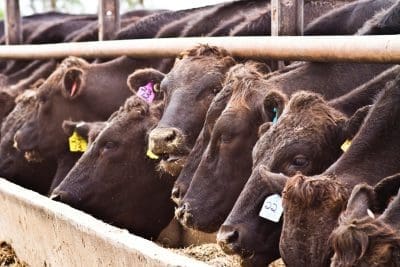CATTLE on feed numbers across Australia are anticipated to fall this year from 2017 highs, under pressure from high feedgrain prices, and the ‘price resilience’ of feeder weight cattle making the trading outlook for grainfeeding cattle look difficult.
 Meat & Livestock Australia’s 2018 Cattle industry projections issued this morning suggests that cattle on feed numbers this year likely to drop below one million head, to average around the 850,000 to 950,000 head through the year.
Meat & Livestock Australia’s 2018 Cattle industry projections issued this morning suggests that cattle on feed numbers this year likely to drop below one million head, to average around the 850,000 to 950,000 head through the year.
The number of cattle on feed reached record highs in 2017 with consecutive March, June and September quarters all reported above one million head. Heightened investment in the lotfeeding sector, growing global demand for high quality grainfed product and more moderate grain prices at the start of 2017 incentivised many lotfeeders to increase numbers and retain cattle for longer.
Additionally, the dry winter and spring conditions across much of Queensland last year also resulted in a greater number of cattle placed on feed rather than finished in the paddock.
This year’s anticipated decline in cattle on feed is being driven by a number of factors, including the fall in grain harvests (ABARES reported the 2017–18 winter harvest was down an estimated 23pc and summer is forecast to fall 41pc nationally, the subsequent lift in feedgrain prices in late 2017 and the growing gap between feeder and finished cattle prices, on a c/kg basis.

“More specifically, when comparing prices at the end of 2017 to those two years earlier, feeder prices have only eased 2pc to 305¢/kg liveweight, while the Queensland 100-day over-the-hooks grainfed steer indicator dropped 9pc to 507¢/kg carcase weight,” Projections said.
“This fall in the 100-day OTH indicator, which is now at its lowest level since mid-2015, is weighing heavily on feedlot margins,” the report said.
The performance and quality of Australian grain crop yields in 2018 will have a major impact on whether this number recovered.
The expected drop in cattle on feed will have a flow-on impact on grainfed exports, which also reached new highs in 2017.
“Considering the headwinds for finished cattle in the increasingly competitive international market, there is likely to be some downward pressure on exports,” MLA said.
Flow-on impact on average carcase weights
Average adult slaughter cattle carcase weights are expected to ease this year, partly as a result of fewer grainfed cattle being turned off.
Adult carcase weights increased almost 10kg year-on-year in 2017 to 298kg, following record numbers of cattle on feed and a low proportion of female slaughter.
In the last ten years, carcase weights have increased across both male cattle (1.4kg/ year) and females (2.8kg/year) on the back of improved genetics, management techniques and growth in the feedlot sector.
In 2018, carcase weights are expected to ease from the record levels of 2017, back in line with long-term trends, but will still be the second highest calendar year average on record, at 293kg.
There are a number of key drivers behind this year-on-year decrease, mainly the drop in the number of cattle on feed, higher grain prices impacting supplementary feeding and female slaughter proportion likely to plateau.
Females are on average 65kg (carcase weight) lighter than their male counterparts, so the proportion of female slaughter has a strong correlation to total average carcase weight.
Total national beef production for 2018 is expected to lift to 2.17 million tonnes – an increase from both 2016 and 2017 levels, but well down on the drought impacted levels of 2013–2015. Overall, the modest increase in slaughter is expected to more than outweigh the anticipated drop in carcase weights.



HAVE YOUR SAY